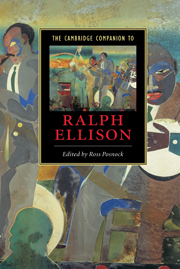Book contents
- Frontmatter
- Introduction
- 1 Ralph Ellison’s invented life
- 2 Ellison and the black Church
- 3 Ellison, photography, and the origins of invisibility
- 4 Ralph Ellison’s music lessons
- 5 Ralph Ellison’s constitutional faith
- 6 Ralph Ellison and the politics of melancholia
- 7 Invisible Ellison
- 8 Ellison’s experimental attitude and the technologies of illumination
- 9 Female iconography in Invisible Man
- 10 Chaos not quite controlled
- 11 Ralph Ellison, Hannah Arendt, and the meaning of politics
- 12 Dry bones
- Selected bibliography and suggestions for further reading
- Index
- Series List
5 - Ralph Ellison’s constitutional faith
Published online by Cambridge University Press: 28 May 2006
- Frontmatter
- Introduction
- 1 Ralph Ellison’s invented life
- 2 Ellison and the black Church
- 3 Ellison, photography, and the origins of invisibility
- 4 Ralph Ellison’s music lessons
- 5 Ralph Ellison’s constitutional faith
- 6 Ralph Ellison and the politics of melancholia
- 7 Invisible Ellison
- 8 Ellison’s experimental attitude and the technologies of illumination
- 9 Female iconography in Invisible Man
- 10 Chaos not quite controlled
- 11 Ralph Ellison, Hannah Arendt, and the meaning of politics
- 12 Dry bones
- Selected bibliography and suggestions for further reading
- Index
- Series List
Summary
Over the years, critics have disagreed about the relation between aesthetics and politics in Ralph Ellison's work. Early evaluations of Invisible Man often praise the richness of Ellison's literary invention without comment on its political significance. Others have disapproved of what they see as Ralph Ellison's preference for the aesthetic over the political. In ''Black Boys and Native Sons,'' Irving Howe famously criticized Ellison and James Baldwin for lacking the confrontational zeal appropriate to a minority writer in a racist society. More recently, Jerry Watts faults Ellison for his ''elitism'' and ''extreme . . . political disengagement.'' Much of this criticism, whether sympathetic or unsympathetic, appears to wish Ellison would choose between art and politics, high culture and folklore, universal themes and the particularities of black experience; otherwise, either his aesthetics or his politics become tangled and suspect. Ellison, however, steadfastly refuses this choice. Instead, his fiction and essays suggest an artistic and democratic vision of justice combining aesthetics and politics, ethics and law, high and vernacular culture, a vision that ''plays havoc with conventional ideas of order,'' such as the categorical division of art and law.
- Type
- Chapter
- Information
- The Cambridge Companion to Ralph Ellison , pp. 104 - 120Publisher: Cambridge University PressPrint publication year: 2005
- 2
- Cited by

